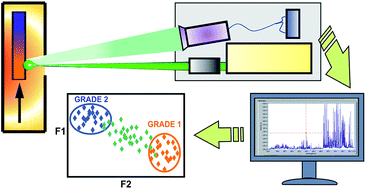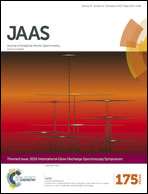Distinction strategies based on discriminant function analysis for particular steel grades at elevated temperature using stand-off LIBS†
Abstract
This work presents experimental discrimination strategies based on advanced chemometric tools for the differentiation of steel grades using stand-off laser-induced breakdown spectroscopy. The experiments are aimed at simulating the conditions existing in the continuous casting line of a steel factory. For this purpose, measurements of the as-cast samples provided by steelmakers have been carried out at a distance of 4.5 m, with samples in motion heated at temperatures up to 900 °C. Coaxial double-pulse laser excitation was used. The main challenge of the present study derives from the formation of an oxide layer on the surface when the steel sample is heated in contact with air. The chemical composition of such a layer deviates significantly from that of the bulk material, and not in a linear way. Moreover, complete removal of the scale layer from the surface with a single laser shot is not feasible. Therefore, quantitative analysis or calibration-based methods have to be discarded and specific chemometric strategies for identification purposes were developed. Discriminant Function Analysis (DFA) has been chosen as the semi-quantitative statistical method for the differentiation of steel grades from the corresponding scale layers. The statistical parameters derived from DFA and discriminant functions are presented with good correlation between real and predicted steel grades.



 Please wait while we load your content...
Please wait while we load your content...